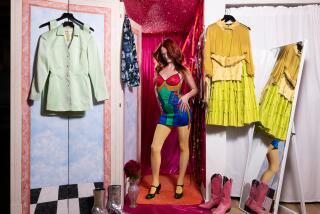Putting a Design on Bigger Market Share
- Share via
Beloved by grammar schoolteachers, the Hoyle Pencil Gripper helps thousands of kids learn the proper way to hold a pencil. Although the company sells about 7 million patented Grippers a year, Hoyle’s marketing consultant decided that the product needed a snazzier appearance to appeal to today’s kids.
“We silk-screened a series of little bears and dinosaurs on the Grippers,” said Jim Schultz, Hoyle’s marketing consultant at the time. “Then, we redesigned the displays to feature more friendly, soft and colorful graphics.”
When the Fillmore, Calif., company started making trendy, neon-colored fluorescent Grippers, sales blasted off.
“Those fluorescent Grippers now represent about 60% of our sales,” said David Hatton, who bought the 15-employee company last year. “We had to understand the market and realize that kids like bright colors.”
Successful small-business owners like Hatton know that making the best product in the world is not enough. In many cases, if your products look dull, people won’t buy them.
Unfortunately, too many small-business owners assume that they can’t afford to hire professional product and packaging designers to create new products or revamp existing ones. But hiring a skilled design consultant for a specific project is much cheaper than putting an in-house designer on your payroll. Many product and package designers, who are entrepreneurs themselves, will either charge you by the hour or work for a percentage of future profits if they believe in what you are doing.
“For start-up ventures, we are willing to participate on a royalty basis,” said Hal Berger, a partner in Image Design & Marketing in El Segundo. “Entrepreneurs do need more than a dream, though; they should have at least $500,000 in seed capital.”
Berger and his partner, Gary Yamron, created Nintendo’s wildly popular Power Glove video game controller in eight weeks. They also just finished designing new store displays for Barbie dolls featuring flashing lights and signs in shades of bright Barbie pink.
“Our goal for Mattel was to design something that appeals to young consumers and has great visual impact in the stores,” Yamron said. By constantly updating Barbie fashions and accessories, Mattel has catered to generations of girls.
For smaller companies, having well-designed products can mean the difference between success and failure.
Even if you don’t have a big marketing budget, the right package and label can boost sales by making your product stand out from the crowd.
“The package itself has to sell your product,” said Eileen Harte, a designer in Van Nuys. “It has to clearly communicate what the product is and be positioned to reach the right consumers.”
Harte also recommends updating your package and labels at least every five to seven years to keep current with design and color trends.
Harte, who designed the bears to decorate the Pencil Grippers, recently created a label for Fresca Foods’ Pastabilities fresh pasta.
“We knew what we didn’t want to do,” said owner Kirk Kuhn, who started making pasta in his kitchen seven years ago. “Our competitor used a black and gold label that looked like death.”
Fresca’s new label incorporates the colors of its unique flavored pastas. So, for example, the squid ink pasta label features black ink.
“We were looking for something that would stand out and grab people’s attention,” Kuhn said. Although the pasta has sold well in upscale markets such as Gelson’s, Kuhn is changing the brand name to Pasta Al Dente because too many people could not pronounce Pastabilities.
If your goal is to improve an existing product, make sure your version not only works better, but also looks better.
“Business owners should take an existing product and ask consumers what is right and what is wrong about it--then remedy what is wrong,” advises Mel Evenson, an award-winning industrial designer who serves as vice president of new product development for Eldon/Rubbermaid.
Evenson believes that a good product designer is a “trend-tracker and a trendsetter who can put you and your products on the leading edge.”
How to Find a Good Designer
* Find a designer familiar with your product or industry.
* Try to hire a designer who is not only skilled about the graphic elements, but also an expert on the market you serve, labeling requirements and trends.
* Interview several designers and review their portfolios before making a decision.
Call their clients and carefully check their references.
* Collect package and product designs that appeal to you so you can share your taste with the designer you hire.
* Ask non-competing business owners whose products you like to recommend their designer.
* To find an industrial designer in your area, look in the Yellow Pages under Designers--Industrial, or contact the Industrial Designers Society of America, 1142 E. Walker Road, Great Falls, Va. 22066. The phone number is (703) 759-0100. The society offers a directory of its 2,200 members for $50.
More to Read
Inside the business of entertainment
The Wide Shot brings you news, analysis and insights on everything from streaming wars to production — and what it all means for the future.
You may occasionally receive promotional content from the Los Angeles Times.










